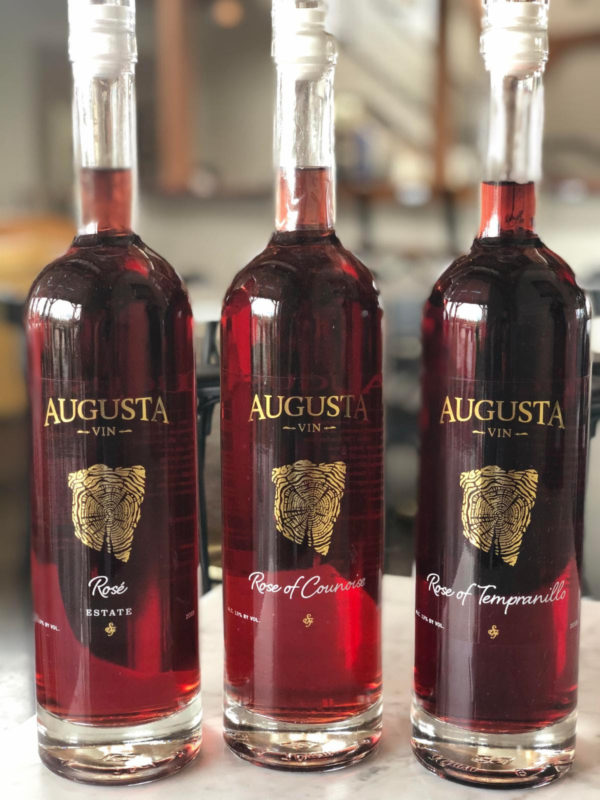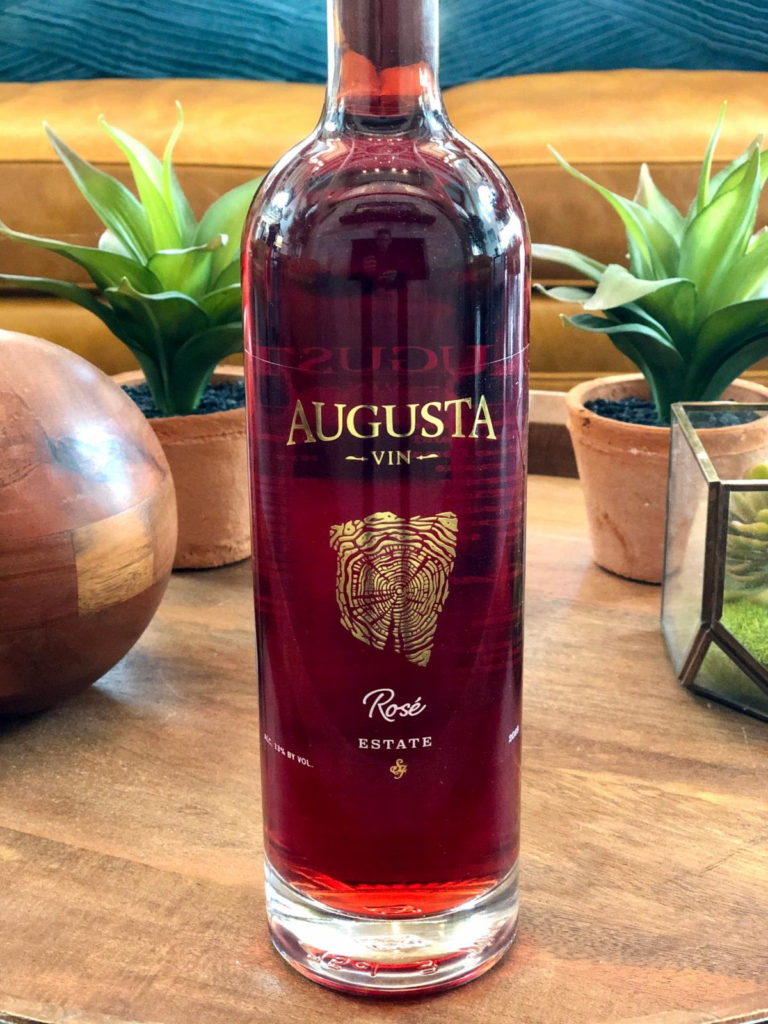Artisan Winemaking: Rosé History & Design

As the weather warms and Texas adopts its traditional summer climate, we at Augusta Vin find that our palates begin to shift, craving crisp and refreshing wines to combat the heat. With an incredible menu fit for any wine preference, our rosé selection is expanding in celebration of International Rosé Day (June 13th)! Throughout the month of June, our menu will also feature a new “Rosé all Day” special tasting. Contact us to set up your reservation today!
This month’s masterclass offers an overview of Rosé History and how our artisan winemaking team crafts excellent Texas Rosés in the traditional Rose model.
What makes a Rosé?
Though Shakespeare had referred to flora roses instead of wine, the point remains. Rosé wine has one of the longest and underrated histories known to civilization. Numerous techniques developed over the centuries to produce “pink” wine, and the Oxford Companion to Wine defines rosé wine as wines “whose colour falls somewhere in the spectrum between red and white.”
The three primary techniques to rosé winemaking are maceration, saignée, and blending, each described below:
Maceration: Perhaps the most common method of rosé winemaking, Maceration (or Limited Maceration) involves limiting skin contact time during the initial stage of fermentation. Because color comes from the grape’s skin, this process leaves the skins on the fruit for a short period of time (usually 6 – 24+ hours) to develop the color and flavor profile desired. The winemaker separates the skins from the juice after this period, effectively halting the red-wine process and initiating the rosé style.
Saignée: Similar to the Maceration style, Saignée winemaking also serves to concentrate a developing red wine while producing a quality rosé. Whereas Maceration removes the skins from the juice, the Saignée method removes juice from the skins after the short maceration period. This method is used when the vintner’s goal is to produce a richer rosé wine and offers a more limited product. This technique is the primary style used in developing Augusta Vin Rosés.
Blend: Perhaps the oldest style of rosé winemaking, the blending technique combines a small amount of finished red wine in a finished white wine to blend flavors, resulting in a pink color. To the modern wine drinker, this technique sounds bizarre and is actually illegal in a number of French appellations, as Champagne is the only appellation permitted to blend red and white wines to produce a champanoise rosé.
History and Fame
A wine style with one of the richest histories in the book, Rosé winemaking is largely considered the first formal style of wine. According to GuidSomm’s Victoria James, many of the first recorded wines were ancient Grecian rosé wines, created from a mass crushing of grapes regardless of skin color, thus inventing the blended rosé. As these grapes were transported through trade and cultivated in different climates, vines evolved and viticultural techniques shifted away from blending red and white skinned grapes toward focusing on creating a rose-colored wine from individual red-skinned grapes.
From the Middle Ages until the 1800’s, a Bordeaux wine nicknamed “Claret” grew to French and English fame as a fashionable red wine that maintained a pink color and offered a more refreshing palate. In America, 1869, the “white Zinfandel” made its way on the wine scene, but would struggle to gain traction in the wine world for nearly a century. This trend continued to grow through the 19th century as rosé became known as vin de soif, or a “wine to quench thirst,” and was beginning to be chilled for service. Midway through the 20th century, a hyperproduction of rosé wines tarnished the style as low quality and prone to a short shelf-life.
Rosé’s revival would begin in America in the 1970’s, sponsored by music stars on their rise to fame, though rose would still struggle to make its way into the “fine wine” world until the early 2000’s. In Europe, legislation had long prohibited blending white and red wines to create rosé. In 2009, seeking to meet a new rise in demand, the European Union moved to change this prohibition and revive the blending technique in rosé winemaking. Until this point, only Champagne winemakers allowed to blend red and white grapes for rosé champagnes. France chose to not change their appellation laws, resulting in a renewed debate concerning rosé quality and production style. Meanwhile in America, celebrities were the champions of refreshing rosé, officially helping the wine to break ground in the world of fine dining and fine wine.
Today, rosé is a summer favorite for many wine drinkers world wide, and is especially popular in the state of Texas. A refreshing wine that is easy to enjoy on its own or paired with poultry, salads, and salmon, rosé has become a classic feature in modern wine culture. Our collection currently includes a Rosé of Counoise, Rosé of Tempranillo, and our newest 2019 Rosé blend! Check out our methods and tasting notes below!
Augusta Vin & Rosé - What's our process?
Grapes: We use a variety of red grapes to craft our Rose wine, including Counoise, Tempranillo, Aglianico, Grenache, Sangiovese, Malbec, and Montepulciano.
Method: Our primary rosé winemaking style is the Saignée method.
Pairing: When pairing a rosé, as with any wine, there is no “one dish fits all” approach, however the delicacy of a dry wine can predictably excel in the presence of creamy cheeses, earthy game, herbs, seasonal fruits, salads, and sundried tomatoes.
Masterclass by:
Dane Sanvido – Augusta Vin – Winemaker
Katie Bishop, Sommelier – Augusta Vin, Wine Club Manager
Andre Boada, Advanced Sommelier – Augusta Vin
References
“Rose Winemaking.” The Oxford Companion to Wine. Oxford UP, 2006. pp. 628.
James, Victoria. “A Brief History of Rosé.” GuildSomm, 2017.
2019 Rosé - New Release! Deductive Tasting Notes
Our newest Rosé is here! A wine club exclusive until June 30, the 2019 Rosé is now available in the tasting room online or for order on our online store here. An estate blend of Grenche, Sangiovese, and Montepulciano, this rosé is the perfect pairing for a sunny afternoon picnic or a relaxing evening on the porch.
Email andre@augustavin.com to learn more and compare notes!
Sight
Clarity: Clear
Concentration: Moderate
Color: Salmon hue

Nose
Intensity: Moderate
Age: Youth
Fruit: Stella Cherries, Ripe Strawberry
Non-Fruit: Rose pedals
Earth/Herb: Flint
Palate
Sweetness: Dry
Fruit: Stella Cherries & Strawberry
Non-Fruit: Lavender
Bitterness: Low
Acid: Moderate
Alcohol: Medium
Finish: Long
Pairing our 2019 Rosé
This Provence styled Rosé is lively and aromatic singing with fresh red berry notes. Pair with lighter style cuisines. Our favorite, a spring mix salad with goat cheese, local Texas pecans and fresh strawberries. Also a brunch option, chanterelle mushroom-gruyere cheese quiche.
Andre Boada, Advanced Sommelier – Augusta Vin
Katie Bishop, Sommelier – Augusta Vin, Wine Club Manager
Marshall Sereno, Sommelier – Augusta Vin
Other articles in the Wine Educational Series
Most Recent
Receive new Wine Educational Series articles
Exlcusive Events
Enjoy your favorite vino and view at Augusta Vin on the upcoming events at the Estate! Click below to see the calendar.

